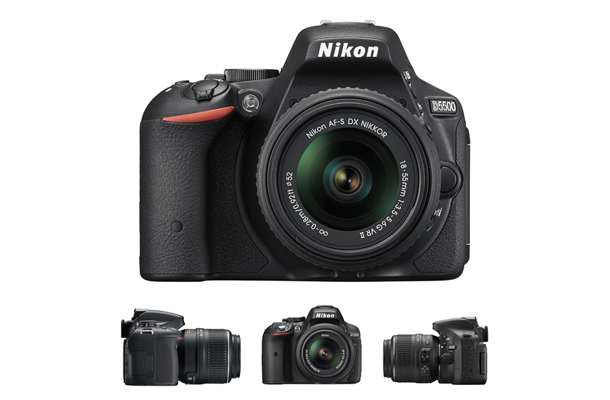Nikon D5500 vs D5300 vs D5200 vs D5100: 13 key differences you need to know

The new Nikon D5500, D5300 and D5100 and D5200 are all now intriguing options in Nikon's DX DSLR range, but which is best for your needs? Our extensive Nikon D5500 vs D5300 vs D5200 vs D5100 comparison looks at what each camera can offer.

Nikon has announced a new camera in its beginner line-up at CES, the annual consumer electronics show over in Las Vegas. The D5500 sits alongside the other D5XX cameras in its range. At the time of the D5300's release, Nikon announced the older D5100 and D5200 models would continue, and while the company is yet to confirm whether all four will stay in the line-up, all four should remain available to buy for some time yet.
As such, all of them are now intriguing options in Nikon's Nikon's DX DSLR range, but which is best for your needs? Our extensive Nikon D5500 vs D5300 vs D5200 vs D5100 comparison looks at what each camera can offer.
This piece examines all four cameras, fully updated to include the D5500 and its new specifications. At first glance, it would seem like the D5500 is merely an incremental upgrade from the D5300, and with this piece we'll be examining whether that's true or whether it's worth the upgrade.
All four Nikon cameras are aimed at creative amateurs and people upgrading from compact digital cameras, all four share a compact, lightweight design with flip-out LCD display, and all three offer quite sophisticated photographic controls and effects.
So here is a blow-by-blow Nikon D5500 vs D5300 vs D5100 vs D5200 comparison of key specifications so that you can see the differences and decide what's most important to you.

So here is a blow-by-blow Nikon D5300 vs D5100 vs D5200 comparison of key specifications so that you can see the differences and decide what's most important to you.
Get daily insight, inspiration and deals in your inbox
Sign up for breaking news, reviews, opinion, top tech deals, and more.
Buy the Nikon D5500 on Amazon US
Buy the Nikon D5300 on Amazon US
Buy the Nikon D5300 on Amazon UK
Buy the Nikon D5100 on Amazon US
Buy the Nikon D5100 on Amazon UK
Buy the Nikon D5200 on Amazon US
Buy the Nikon D5200 on Amazon UK
Nikon D5500 vs D5300 vs D5200 vs D5100: 01 Sensor

• D5100 16.2 megapixels
• D5200 24.1 megapixels
• D5300 24.2 megapixels (no OLPF)
• D5500 24.2 megapixels (no OLPF)
All four cameras have DX-format CMOS sensors, but where the older D5100 has 16.2 million pixels, the D5200 and D5300 both have 24 million pixels.
It's a sizeable increase, but in real-world shooting you'll need the best lenses and perfect shooting technique to see the difference.
The Nikon D5200 and D5300 are not quite the same, though. In the D5300 the OLPF (Optical Low Pass Filter) has been removed to make very fine detail sharper still. The new D5500 also sticks with the same resolution and lack of a low pass filter - and the fact that Nikon hasn't called the camera inside the sensor "new" suggests that it's the same as the D5300's device.
These filters are used to prevent moire interference effects with fine patterns and fabrics, but Nikon has decided that at this level of sensor resolution the gain in sharpness offsets any increased risk of artefacts.
Nikon D5500 vs D5300 vs D5200 vs D5100: 02 ISO range

• D5100 ISO 100-6400, expandable to Hi 2 25600
• D5200 ISO 100-6400, expandable to Hi 2 25600
• D5300 ISO 100-12800, expandable to Hi 1 25600
• D5500 ISO 100 - 25600
The Nikon D5200 kept the same ISO range as the Nikon D5100, despite the increase in resolution, which would normally reduce high ISO performance.
The Nikon D5300 goes a step further, expanding the normal range to ISO 12800, but keeping the maximum 'expanded' value of 25600.
Nikon says this has been made possible by the D5300's new and more powerful Expeed 4 processor, and cites the high ISO performance as one of the new camera's key attributes. The Nikon D5500 specs page cites a native range of ISO 100 - 25600, suggesting that performance at the very top of the range will be an improvement on its predecessor - good news for low light shooters.
SEE MORE: 10 common exposure problems every photographer faces (and how to fix them)
Nikon D5500 vs D5300 vs D5200 vs D5100: 03 Image processing

• D5100 Expeed 2
• D5200 Expeed 3
• D5300 Expeed 4
• D5500 Expeed 4
It's not just cameras which are continually developed, but their on-board processors too. Successive generations of Expeed processors have enabled Nikon to keep improving the image quality, particularly the high ISO noise reduction.
The Nikon D5100 uses an Expeed 2 processor, the D5200 has a more advanced Expeed 3 processor and the D5300 uses a brand new Expeed 4 system. Nikon has stuck with the same processor for the Nikon D5500.
PAGE 1 - Nikon D5500 vs D5300 vs D5100 vs D5200: Sensor, ISO range, Image processing
PAGE 2 - Nikon D5300 vs D5200 vs D5100: Continuous shooting, AF & Viewfinder
PAGE 3 - Nikon D5300 vs D5200 vs D5100: LCD display, Effects & Movie modes
PAGE 4 - Nikon D5300 vs D5200 vs D5100: Wi-fi and GPS, Construction, Battery & Price
PAGE 5 - Nikon D5300 vs D5200 vs D5100: What we think
READ MORE
100 Nikon DSLR tips you need to know right now
49 seriously good Canon DSLR tips, tricks, shortcuts and time-savers
Nikon D610 vs D600: what's new and what isn't on Nikon's new full-frame DSLR?
Nikon D600 vs D800: 20 things you need to know
49 awesome photography tips and time savers